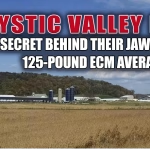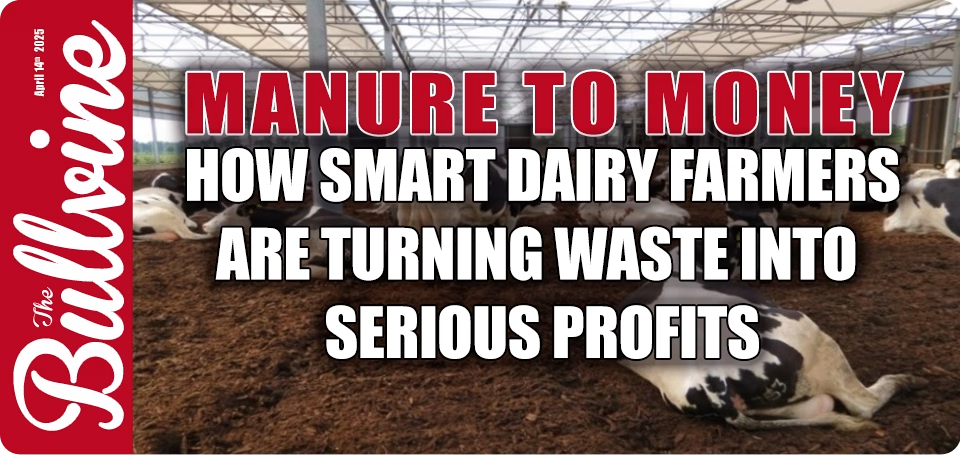Latest News
CME Dairy Market Report: April 16, 2025 – Cheddar Blocks Surge While Barrels Reverse Course; Butter Continues Decline Amid Stable Powder Markets
Cheese markets split as blocks surge and barrels tumble; butter slides further while global signals flash warning signs for US producers. EXECUTIVE SUMMARY: The […]Double-Ovsynch or Double E-Synch? Which Fertility Program Will Boost Your Herd’s Pregnancy Rates?
Double E-Synch rivals Double-Ovsynch! New research shows 10% fertility boost in high-producing cows & 86hrs/year labor savings. Game-changer? Executive Summ […]AI Eyes on Your Herd: Why Automated Lameness Detection Is Revolutionizing Dairy Farming
AI spots lame cows 23 days before humans. Dairy farmers: Is your herd's $500/cow/year profit drain hiding in plain sight? EXECUTIVE SUMMARY: Automated 2D imagin […]The Impact of Tariffs on Global Dairy Demand: A Sector Under Pressure
Tariffs are reshaping dairy demand—discover which products thrive or die in the trade war crossfire. EXECUTIVE SUMMARY: Tariffs are fracturing global dairy mark […]Protein Power Play: How Dairy Can Dominate The GLP-1 Revolution
GLP-1 drugs are reshaping diets. Dairy’s protein edge could dominate this $260B shift—if farmers act now. The clock’s ticking. EXECUTIVE SUMMARY: The rise of GL […]
More News
- Dairy Profit Squeeze 2025: Why Your Margins Are About to Collapse (And What to Do About It)
- CME Dairy Report: Cheese Barrels Surge to Rare Premium Over Blocks as Markets Show Strength
- Tariffs: The Hidden Hand Milking Your Bottom Line
- Global Dairy Trade Surges 1.6%: Lactose Skyrockets 22% While Powder Markets Falter
- Winning the Weed Chess Game: Why Your Dairy Farm’s Bottom Line Depends on Smarter Strategies
- 84% TARIFF SHOCK: How the US-China Trade War Will Reshape Your Dairy Business
- Is Your Herd Safe? Cybersecurity Essentials for Modern Dairy Farms
- Dairy Titans Unite: Arla-DMK Merger Reshapes Europe’s Dairy Landscape
- FMD at The Doorstep: Why Poland’s Dairy Industry Is Holding Its Breath
- CME Dairy Market Report: April 14, 2025 – Cheese Prices Surge on Active Trading Despite Bearish USDA Outlook; Butter, Powders Remain Static Amid Market Pause
Top News Posts from Past Week
- Dairy’s Golden Calf Rush: $1,000+ Crossbreds Reshape Farm Economics
- Trump’s $998-A-Day Migrant Fines: Is it a Death Sentence for America’s Dairy Industry?
- Mega-Dairy Revolution: Inside the World’s 10 Largest Dairy Farms
- Milk Tsunami Ahead: USDA Exposes 2025 Price Crash Triggers
- $4,000 Heifer Shock: Replacement Heifer Prices Reach Record Territory
- The $1,000 Calves & $4,000 Springers: How Long Will This Gravy Train Keep Rolling?
- Double-Ovsynch or Double E-Synch? Which Fertility Program Will Boost Your Herd’s Pregnancy Rates?
- Dairy Titans Unite: Arla-DMK Merger Reshapes Europe’s Dairy Landscape
- H5N1 Crisis Hits 1,000 U.S. Dairy Herds: California Epicenter and Nevada’s New Viral Threat Demand Immediate Action
- 84% Chinese Tariffs Slam US Dairy: Why Whey & Lactose Exports Face Crisis
Feature Articles
Hearts of the Heartland: Young Dairy Farm Girls’ Extraordinary Battles for Life
Young dairy farm girls Lexi, Reese & Sydni defy death through transplants, fire recovery & paralysis—proving resilience rooted in rural communities and […]5 Powerful Stress-Busting Techniques Every Dairy Farmer Needs This Spring
Beat spring burnout! 5 science-backed strategies dairy farmers use to survive calving season and thrive. Mental health = farm health. E236 5 Powerful Stress-Bus […]Mystic Valley Dairy: The Secret Behind Their Jaw-Dropping 125-Pound ECM Average
Wisconsin's Mystic Valley Dairy shatters records with 125 pounds of energy-corrected milk daily. Discover how "doing 100 little things right" creates extraordin […]MANURE TO MONEY: How Smart Dairy Farmers Are Turning Waste into Serious Profits
Dairy farmers are flushing away $15,000 per 100 cows annually. Discover how savvy producers are turning manure into a goldmine through strategic composting. E23 […]Hanoverhill Starbuck’s DNA Dynasty: The Holstein Legend Bridging 20th-Century Breeding to Genomic Futures
From $2,500 calf to genetic revolution: How one bull's DNA reshaped global dairy farming and still whispers in 83% of Holsteins today. E233 Hanoverhill Starbuck […]
More Articles
- Revolutionary Colostrum Protocol Adding $500 Per Heifer to Your Bottom Line
- 2024 Holstein Canada Master Breeders: Excellence in Balance, Breeding, and Legacy
- Dad at 80: How Murray Hunt Revolutionized Canadian Dairy Genetics
- When Faith Meets Farming: Mark Yeazel’s Amazing Journey from Holstein Breeder to Tanzanian Dairy Missionary
- BLACK HIDE BLINDNESS: Why Breeding Only for Color is Destroying Your Dairy-Beef Profits
- Stud Wars: April 2025 – The Genetic Force Awakens
- From Show Ring to Genomic Legacy: The Transformative Impact of Aitkenbrae Starbuck Ada on Holstein Breeding
- Spring Pasture Powerplay: Balancing Grazing Efficiency with Milk Component Goals
- Unlocking Dairy Robot Financing: How Smart Farmers Are Funding Their Automated Future
- Rising to Excellence: The Remarkable Journey of Cord Hormann and Wilcor Holsteins
Top Feature Articles from the Past Month
- Top 15 Best Milk Brands in the USA: Unveiling the Cream of the Crop
- Northeast Spring National Holstein Show 2025
- The Cow That Built an Empire: Comestar Laurie Sheik’s Unstoppable Genetic Legacy
- 10 Sires To Breed The Next World Dairy Expo Grand Champion
- Why Donald Trump Hates Canada’s Dairy Supply System
- Hanoverhill Starbuck’s DNA Dynasty: The Holstein Legend Bridging 20th-Century Breeding to Genomic Futures
- CAPTAIN: The Bull That Rewrote the Rules for Modern Breeding
- Making Dreams Come True: The Journey of Tom & Kelli Cull
- The $4,300 Gamble That Reshaped Global Dairy Industry: The Pawnee Farm Arlinda Chief Story
- Bull in a China Shop: How Juan Moreno Turned the Dairy World Upside Down
- Hearts of the Heartland: Young Dairy Farm Girls' Extraordinary Battles for Life
-
Hearts of the Heartland: Young Dairy Farm Girls’ E…
Andrew Hunt Apr 16, 2025Young dairy farm girls Lexi, Reese & Sydni defy death through transplants, fire recovery & paralysis—proving resilience rooted in rural communities and dairy cattle bonds. E237 Hearts of the Heartland: Young Dairy Farm Gir | RSS.com When discussing strength in the dairy industry, the… Read More - 5 Powerful Stress-Busting Techniques Every Dairy Farmer Needs This Spring
-
5 Powerful Stress-Busting Techniques Every Dairy F…
Andrew Hunt Apr 16, 2025Beat spring burnout! 5 science-backed strategies dairy farmers use to survive calving season and thrive. Mental health = farm health. E236 5 Powerful Stress-Busting Techniques Every Da | RSS.com Spring brings more than just new growth to your dairy operation—it delivers a perfect storm of str… Read More
- Mystic Valley Dairy: The Secret Behind Their Jaw-Dropping 125-Pound ECM Average
-
Mystic Valley Dairy: The Secret Behind Their Jaw-D…
Karen Hunt Apr 15, 2025Wisconsin's Mystic Valley Dairy shatters records with 125 pounds of energy-corrected milk daily. Discover how "doing 100 little things right" creates extraordinary results. E235 Mystic Valley Dairy: The Secret Behind Their | RSS.com Ever wonder what it takes to run a dairy farm where cows pr… Read More
- MANURE TO MONEY: How Smart Dairy Farmers Are Turning Waste into Serious Profits
-
MANURE TO MONEY: How Smart Dairy Farmers Are Turni…
Andrew Hunt Apr 14, 2025Dairy farmers are flushing away $15,000 per 100 cows annually. Discover how savvy producers are turning manure into a goldmine through strategic composting. E234 MANURE TO MONEY: How Smart Dairy Farmers Are | RSS.com While your neighbors complain about your farm's smell and regulators circle… Read More
- Hanoverhill Starbuck's DNA Dynasty: The Holstein Legend Bridging 20th-Century Breeding to Genomic Futures
-
Hanoverhill Starbuck’s DNA Dynasty: The Holstein L…
Andrew Hunt Apr 12, 2025From $2,500 calf to genetic revolution: How one bull's DNA reshaped global dairy farming and still whispers in 83% of Holsteins today. E233 Hanoverhill Starbuck’s DNA Dynasty: The Holst | RSS.com The legendary Hanoverhill Starbuck, pictured here at 5 years old by photographer Jim Rose, stands… Read More
- Revolutionary Colostrum Protocol Adding $500 Per Heifer to Your Bottom Line
-
Revolutionary Colostrum Protocol Adding $500 Per H…
Andrew Hunt Apr 11, 2025Are you discarding liquid gold? Discover how extended colostrum feeding adds $500 per heifer while slashing treatment costs and boosting lifetime milk. E232 Revolutionary Colostrum Protocol Adding $500 | RSS.com Your current calf feeding program may be limiting your profitability by up to $5… Read More
- 2024 Holstein Canada Master Breeders: Excellence in Balance, Breeding, and Legacy
-
2024 Holstein Canada Master Breeders: Excellence i…
Andrew Hunt Apr 10, 202519 Canadian dairy farms earn elite 2024 Master Breeder status—discover the secrets behind their balanced breeding success! E230 2024 Holstein Canada Master Breeders: Excelle | RSS.com The Holstein Canada Master Breeder shield represents the pinnacle of achievement in dairy cattle breeding – a… Read More
- Dad at 80: How Murray Hunt Revolutionized Canadian Dairy Genetics
-
Dad at 80: How Murray Hunt Revolutionized Canadian…
Andrew Hunt Apr 9, 2025At 80, Murray Hunt’s dairy genetics innovations still shape global herds—meet the visionary who made science the farmer’s ally. E229 Dad at 80: How Murray Hunt Revolutionized Can | RSS.com My father Murray Hunt at 80: The quiet visionary who transformed Canadian dairy breeding with scientific… Read More
- When Faith Meets Farming: Mark Yeazel's Amazing Journey from Holstein Breeder to Tanzanian Dairy Missionary
-
When Faith Meets Farming: Mark Yeazel’s Amazing Jo…
Karen Hunt Apr 9, 2025From elite Holstein breeder to Tanzanian missionary: How Mark Yeazel trades show rings for orphan care through dairy farming. E228 When Faith Meets Farming: Mark Yeazel’s Amazi | RSS.com You know what gets me? Stories about dairy farmers who entirely flip the script on their careers. And man,… Read More
- BLACK HIDE BLINDNESS: Why Breeding Only for Color is Destroying Your Dairy-Beef Profits
-
BLACK HIDE BLINDNESS: Why Breeding Only for Color…
Andrew Hunt Apr 8, 2025Black hide obsession is costing you thousands. Those cheap Angus straws? Economic suicide. Discover why color alone won't save your beef-on-dairy profits. E227 BLACK HIDE BLINDNESS: Why Breeding Only for C | RSS.com You're riding a fading trend, and your bottom line will pay the price. Since… Read More
Tanbark Trail
Northeast Spring National Holstein Show 2025
March 31st, 2025 @ Hamburg, NY E217 Northeast Spring National Holstein Show 2025 | RSS.com The New York Spring Holstein Show, judged by Ryan Krohlow, showcased exceptional dairy cattle across multiple age divisions. The competition featured remarkabl […]Is Erbacers Snapple Shakira One of the Greatest Show Cows of All Time?
Uncover why Erbacres Snapple Shakira stands among the top dairy show cows of all time. What makes her excel in the competitive dairy arena? E55 Is Erbacers Snapple Shakira One of the Greatest Show Cows of All Time? From the moment she steps into the […]The Royal Winter Fair 2024 – Jersey
Judge Jeff Sales NTENSE JOEL DELPHIE ETGrand ChampionThe Royal - Jersey Show 2024WEEKSDALE/HI-CALIBER/ROCK ALLEN/F&D BORBA, BREADALBANE, PE c LEACHLAND VIDEO MOCHA K Intermediate Champion The Royal - Jersey Show 2024 WEEKSDALE HOLSTEINS, BRE […]The Royal Winter Fair 2024 – Holstein
Judge Blair Weeks JEFFREY-WAY HARD ROCK TWIGS Grand Champion The Royal - Holstein Show 2024 K. DOEBERIENER, L. BOWEN & PAT CONROY, R&F LIVESTOCK INC, & WALKER DAIRY INC. Grand Champion: Jeffrey-Way Hard Rock Twigs, 1st 4-year-old, K Doebe […]The Royal Winter Fair 2024 – Red & White Holstein
November 4th 2024 Judge: Markus Hehli, Rimbey, AB PREMIUM APPLE CRISP LILLY Grand Champion The Royal - Red & White Holstein Show BUTLERVIEW FARM, CHEBANSE, IL Grand Champion: Premium Apple Crisp Lilly (Apple-Crisp), 1st 5-year-old, Butlerview Far […]
The Bullvine LLC © 2025 | Terms of Use | Community Guidelines | Privacy Policy |
Manage Consent
To provide the best experiences, we use technologies like cookies to store and/or access device information. Consenting to these technologies will allow us to process data such as browsing behavior or unique IDs on this site. Not consenting or withdrawing consent, may adversely affect certain features and functions.
Functional Always active
The technical storage or access is strictly necessary for the legitimate purpose of enabling the use of a specific service explicitly requested by the subscriber or user, or for the sole purpose of carrying out the transmission of a communication over an electronic communications network.
Preferences
The technical storage or access is necessary for the legitimate purpose of storing preferences that are not requested by the subscriber or user.
Statistics
The technical storage or access that is used exclusively for statistical purposes.
The technical storage or access that is used exclusively for anonymous statistical purposes. Without a subpoena, voluntary compliance on the part of your Internet Service Provider, or additional records from a third party, information stored or retrieved for this purpose alone cannot usually be used to identify you.
Marketing
The technical storage or access is required to create user profiles to send advertising, or to track the user on a website or across several websites for similar marketing purposes.






























